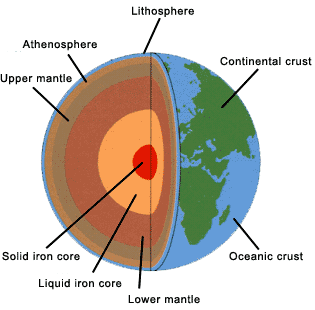What are Earth's Interior Layers
The Earth's interior
Three major layers
Three major layers inside the Earth interior are the crust, mantle and the core. Scientists divide the mantle into the upper and lower mantle. The core is divided into a liquid outer core and a solid inner core.
Earthquake waves used to find Earth's interior layers
It is impossible for drilling equipment to drill to the core of the Earth. Instead scientists use earthquake waves to determine what lies beneath our feet. They have found the Earth's interior has a number of layers. Earthquake waves are deflected when the density of the rocks changes which scientists use to determine the different layers inside the Earth.

The Earth's layers, NASA
P waves and S waves are deflected
P waves
P waves speed up when rocks change density. This is how the mantle crust boundary was discovered. The earthquake waves speed up at the boundary and are slightly deflected by the increased density of the rocks.
S waves
S waves, produced by all earthquakes, are stopped when they reach the outer core of the Earth. S waves travel only through solids. They do not travel through liquids and gases.

Have ever wanted to know more about the planet you live on. Our Earth Science book has 15 chapters about the Earth. You will learn fascinating information about plate tectonics, igneous rocks, the oceans, and much more in this fun book about our planet. Myrna

Click for More Information and to Order
Isaac Newton determined the density of Earth
Isaac Newton's studies
Three centuries ago Isaac Newton calculated the average density of our planet. He used his study of the planets and the force of gravity to determine the average density of Earth. He discovered that the rocks in the interior of the Earth had to be much denser than crustal rocks found on the surface of the Earth.
Estimating the density of the Earth
Today scientists have many more instruments to study the Earth and have determined that Newton's estimate of the Earth's density was essentially correct. The density of the continental crust is between 2.7 and 3.0 g/cm³. The density of the oceanic crust is between 3.0 and 3.3 g/cm³.The average density of the core is 10.7 to 12 g/cm³. The inner core, which is solid, is approximately 13.5 g/cm³.
Discovering the core of the earth
Earth's cores
The Earth's core has two layers that are primarily iron. It is estimated that 90% of the core is iron with the remaining 10% an alloy of iron that is combined with oxygen, sulfur or nickel.
Liquid outer core
The Earth's liquid outer core was discovered by Beno Gutenberg in 1913 when he was studying earthquake waves inside the Earth. Gutenberg discovered that S waves were stopped at a boundary that lies 2,890 km beneath our feet. The liquid outer core is about 2,400 km thick.
Earth's magnetic field
The liquid outer core creates Earth's magnetic field. The intense heat and pressure cause the rock to melt in this layer. The increasing heat and pressure are so great that the iron and its alloys have become solid in the inner core.
Discovering Earth's inner core
Inge Lehmann's research
The Earth's inner was discovered by Inge Lehmann, a Danish seismologist in 1936. Lehman was studying P waves that were produced by earthquakes in New Zealand. She discovered that P waves were reflected off a boundary inside the core of the Earth that can be detected by sensitive seismographs. The inner core that Lehmann, discovered has a diameter of 1221 km.
KIDS FUN Science Bookstore
Check out Myrna Martin's award winning textbooks, e-books, videos and rock sets. The Kids Fun Science Bookstore covers a wide range of earth science topics. Click here to browse.










